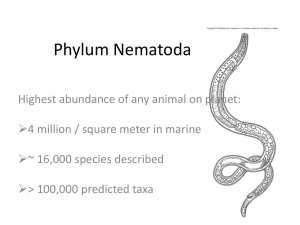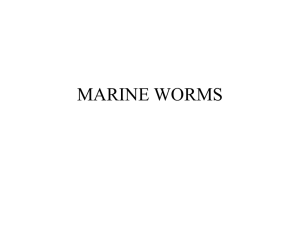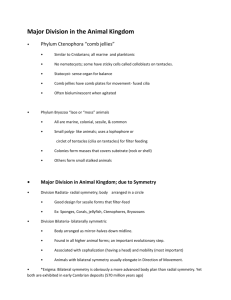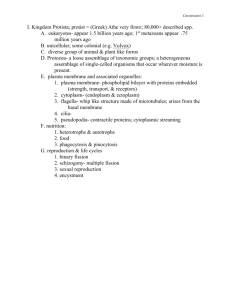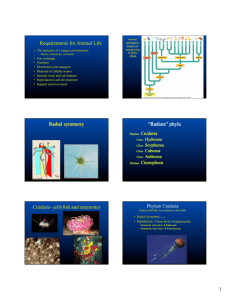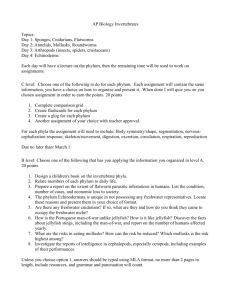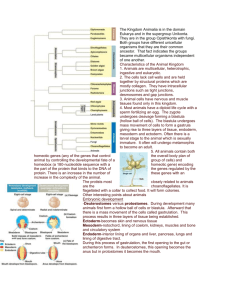Notes - Chapter 29
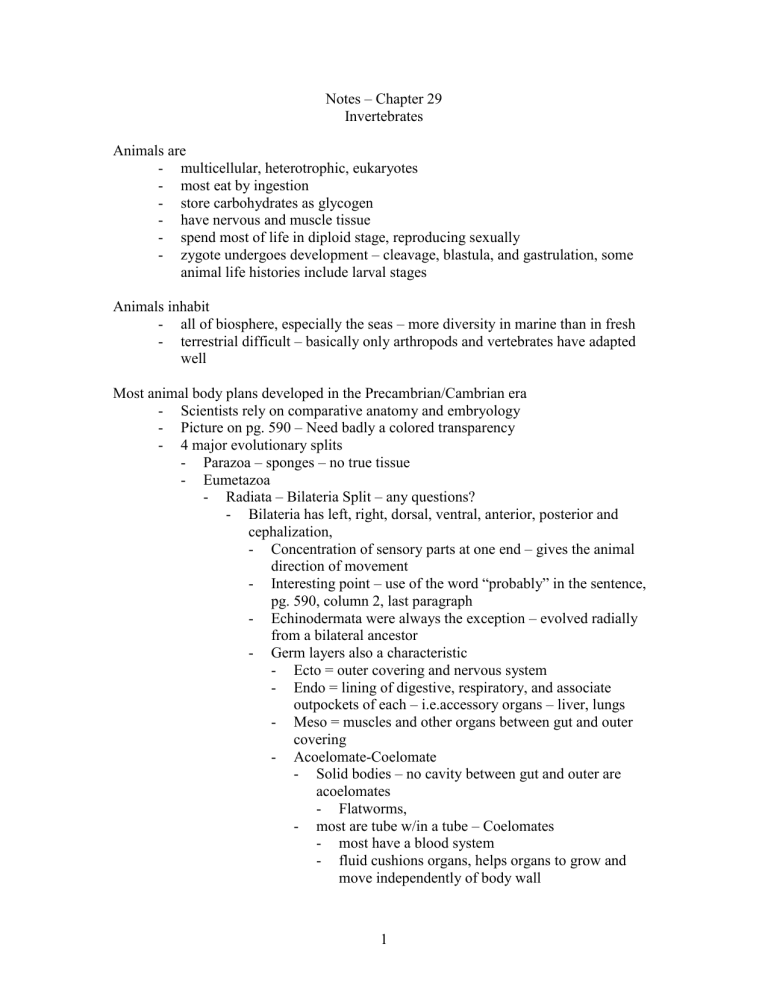
Notes – Chapter 29
Invertebrates
Animals are
multicellular, heterotrophic, eukaryotes
most eat by ingestion
store carbohydrates as glycogen
have nervous and muscle tissue
spend most of life in diploid stage, reproducing sexually
zygote undergoes development – cleavage, blastula, and gastrulation, some animal life histories include larval stages
Animals inhabit
all of biosphere, especially the seas – more diversity in marine than in fresh
terrestrial difficult – basically only arthropods and vertebrates have adapted well
Most animal body plans developed in the Precambrian/Cambrian era
Scientists rely on comparative anatomy and embryology
Picture on pg. 590 – Need badly a colored transparency
4 major evolutionary splits
Parazoa – sponges – no true tissue
Eumetazoa
Radiata – Bilateria Split – any questions?
Bilateria has left, right, dorsal, ventral, anterior, posterior and cephalization,
Concentration of sensory parts at one end – gives the animal direction of movement
Interesting point – use of the word “probably” in the sentence, pg. 590, column 2, last paragraph
Echinodermata were always the exception – evolved radially from a bilateral ancestor
Germ layers also a characteristic
Ecto = outer covering and nervous system
Endo = lining of digestive, respiratory, and associate outpockets of each – i.e.accessory organs – liver, lungs
Meso = muscles and other organs between gut and outer covering
Acoelomate-Coelomate
Solid bodies – no cavity between gut and outer are acoelomates
Flatworms,
most are tube w/in a tube – Coelomates
most have a blood system
fluid cushions organs, helps organs to grow and move independently of body wall
1
Protostome – Deuterstome split
Proto – mollusks, annelids, arthropods,
Deutero – echinos, chordates
Proto cleavage – spiral, determinate
Single cell could not survive on its own
Deutero – radial, indeterminate
Could survive independently, this is what makes identical twins possible, and possibly the cutting up of a starfish – regeneration
difference in forming of the “mouth” end vs. the
“anal” end
Phylum Porifera – Sponges
sessile, lack true tissues (groups of cells performing a unified function)
1 cm – 2 m height range
9,000 species, 100 – fresh, the rest, marine
no organization
usually have central cavity
filter feeders
cells ingest by phagocytosis
central cavity lined by amoebacytes – digest food, pass it on, make fibers made of calcium carbonate or silica or spongin (that’s the part of the sponge that persists when the actual animal is dead) Where is Mary Lou Wood when I need her? I want her glass sponge!!!!!!!! Maybe I’ll just order one!!!
Hermaphrodites – both sexes in same organism
Phylum Cnidaria (the C is silent)
Hydras, jellyfish, sea anemones, corals
10,000 species, most marine
have gastrovascular cavity – “gut”
two life stages – alternations of generations, in some, actually
polyp – asexual,
sessile, adheres to substrate, hydras and sea anemones
medusa – sexual
flattened, free floating,
jellyfish, for example
Chrysoara quinquechirra
– the sea nettle, the Chesapeake’s finest!
Carnivorous, have cnidocytes – cells w/ stingers, harpoons – contain nemotocysts – stinging capsules
97% water – hydrostatic skeleton
nerve net, very simple nerve coordination, no brain
Hydrozoa
Hydra
Scyphozoa
Jellyfish, lives most of life as medusa
Anthozoa
2
Sea anemones (animal flowers) and corals
Coral – build up calcium carbonate skeletons – reefs, Barbados, etc.
Phylum Ctenophora
Comb jellies – 100 species, all marine
Have comblike plates of fused cilia, largest animals to use cilia for locomotion
Show movie, jellyfish
Phylum Platyhelminthes
flatworms – 20,000 species
flukes and tapeworms (parasitic) and planaria (Go Kate!)
microscopic to 20 m long
bilateral
Class Turbellaria – Planaria (Show life on earth)
Nonparasitic, carnivores, love meat
Developed flame cells to get rid of nitrogenous waste, keep osmotic balance, allowed them to “move” into fresh water and wet, terrestrial habitats
Head with eyespots for light and lateral flaps for smell
Slightly more complex nervous system
Actually can modify their response to stimuli, and…can learn right, left, and can learn by ingesting another planarian who has learned
Can reproduce asexually by regeneration, or sexually – even though individuals are hermaphroditic, they cross fertilize
Class Trematoda
Flukes – parasites, other animals, full of reproductive organs
Shistosomiasis – human parasite, - fresh water snail intermediate host, St.
Lucia
Class Cestoda – Tapeworms
parasitic, humans, hooks on head, absorbs food already digested by host
humans can ingest undercooked meat of pigs and cattle which contain larval stages
Phylum Nemertea – ribbon worms????????
actually are the first with a complete digestive system – mouth and anus
Phylum Rotifer
reproduce by parthenogenesis – females produce females from unfertilized eggs
or produce degenerate males, can’t even feed themselves, only produce sperm
Phylum Nematoda – roundworms
very numerous
80,000 species
1mm – 1 m
3
sexual, usually sexes separate
produce > 100,000 eggs/day – very resistant
live in moist soil
some attack plant roots, some human parasites (pinworms and hookworms, guinea worms, I think, trichina worms – pigs, liver, encyst in organs and muscles, like heartworm does in the heart of dogs, and then the filaria worm, lodges in the lymphatic system, causes major swelling called elephantiasis – wish I had pictures, tried on the Internet
Phylum Mollusca
snails, slugs, oysters, clams, all “seashells”, octopus, squid
50,000 species
most marine, but there are some interesting fresh ones – zebra mussels
Soft-bodied, most w/ shell of calcium carbonate, octopi and squid have internalized shell
All have foot, visceral mass of organs, mantle which secretes shell
Most are sexual, separate, but snails are hermaphroditic (think about it, harder to find each other on land – makes a certain very derogatory command seem sensible)
Most have radula to scrape algae to eat, or to eat other mollusks, also siphons to suck water in, so filter feed too (take in all those terrible toxic dinoflagellates)
Reproduction sexual but spawn into water
Class Polyplacophora – Chitons
Segmented shells – modern ancestor of ancient trilobites
Class Gastropoda – one shelled, stomach foot
Largest class, 40,000 species
Snails, slugs, whelks etc. etc. etc.
Torsion – rotation of visceral mass above the body
Most shells conical, but limpets and abalone flattened
First successful group to populate land
lost gills, modified mantle to exchange oxygen in air
Class Bivalvia – two halves of shells
Clams, oysters, mussels, scallops
These have siphons – suspension feeders – suck it in, gills filter, then blow out wastes
Usually fairly sedentary
Mussels secrete threads to hold
Clams burrow in soft bottoms, oysters settle on hard bottoms
Class Cephalopoda – Squid, octopi, and chambered nautilus
Built speed, lots of sense organs, jaws,
Only mollusks with a closed circulatory system (blood always contained in vessels)
Well developed nervous system with complex brain, can learn, show bit of octopus video
4
Phylum Annelida – Segmented worms
15,000 species
1mm – 3 m (giant Australian earthworm)
marine, fresh and terrestrial
specialized regions of digestive tract (crop, gizzard, see birds)
closed circ. System
metanephridia, leads to pores on outside, to get rid of metabolic
hermaphroditic but cross fertilize
Class Oligochaeta – Earthworms
Eats soil, wastes called castings – good for the soil
Darwin estimated – 1 acre British farmland = 50,000 worms = 18 tons of casting per year
Have setae on their sides to help them move
Get oxygen through skin (why they surface during rain!!!)
Class Polychaeta – “many” setae
As well as bristles, have parapodia (feet like structures)
Most are marine, big benthic population in tubes – called epifauna
Picture, pg. 609 – neat colors
Class Hirudinea
The leeches – some parasitic, blood sucking
Either slit skin, or dissolve using enzymes, along with an anesthetic
Medical studies
-
Find out what’s in enzymes and use it to bust clots
Use leeches to restore blood flow to an area closed off by clots, such as when reattaching an appendage with little, tiny blood vessels
****This phylum important for segmentation and coelem
coelem with fluid in it cause hydrostatic pressure, allows greater diversity in locomotion, also provides body space for storage, cushion for internal organs, a place for them to grow and develop, and…..separates body wall movement from organ movement
Phylum Arthropoda – most successful group of animals ever to live!! That’s heavy!
1 billion individuals, 1 million species
roughly 66% of all animals
segmented, hard exoskeleton, and jointed legs
allows for great diversity of specialization
for instances, appendages used for walking, eating, sensing, copulation, defense
exo made of protein and chitin (Ki’ tin)
but, must molt to grow, making them temporarily vulnerable
have lots of sensory – antennae, eyes, smell
open circ. System
coelem only in embryonic stages
5
for respiration, have gills, trachea systems (insects) and book lungs
most believe they evolved from annelids, or share a common ancestor
Four main groups (subphyla, actually)
Trilobites
In fossils, became extinct
Spiders, ticks, scorpions, etc. – called Chelicerates
have anterior appendages used for feeding
Horseshoe crab - only surviving ancient species
Lewes, Delaware beach – May – go there – there are billions who come in to mate – then most of them die and Lewes has to bury them – they stink, too!
-
Use blood to do the ‘Quick” test for chlamydia
Some fear that they will be overharvested for medical purposes so they’re putting down some laws about them
Class Arachnida
- scorpions, spiders, ticks, mites
- 2 body parts, 8 legs
as other arthropods, flies notably, these macerate food with chelicerae, then spit up digestive enzymes to dissolve, then they are absorbed
these guys have book lungs, like pages of a book, big surface area for osmosis
spin webs to catch prey, to wrap food, as droplines, unique design to species
From Arachnids, came Insects (Uniramians)
Millipedes, centipedes (mean, fast son of a guns), and all insects
Pics of butterflies in Costa Rica
Probably one of the earliest land animals
Centipedes use poison claws
Insects outnumber all forms of life
26 orders – all habitats except marine
have specialized mouthparts called mandibles
evolution of flying greatly increased diversity
3 body parts, 6 legs, one or two pairs of wings
lots of wing adaptations – two separate (dragonfly), hooked together (flies), overlapping (butterflies) and posterior ones for flight and anterior ones for protective covering (beetles)
Malpighian tubules for excretion, & trachea tubes for breathing – open at sides
Complex nervous system, even with social behavior
Honeybees, hives, sun dances
Behavior is inherited
See pictures on pgs. 616-617 for main orders
Some undergo incomplete (juvenile look like small adults) and some, complete (egg, larva, pupa, adult)
6
Lots of diversity in reproductive strategies – colors, odors, lights, sound
Sexual with internal fertilization
Many functions – pollinators, disease carriers, crop destroyers
-
Cornell University’s Tom Eisner says, “Bug are not going to inherit the Earth. They own it now. So we might as well make peace with the landlord.”
and Crustaceans
40,000 species, mostly marine
lobsters, crayfish, shrimp, barnacles, copepods (the most numerous single species on Earth), and roly-polys (only terrestrial crustacean), also isopods and amphipods, krill
use calcium carbonate to harden their shell
Now, we switch to Deuterosomes……
Phylum Echinodermata – starfish, sea urchins, sand dollars, sea cucumbers
sort of seems out of place here but they have the criteria – form a true co elom, mouth and anus place in embryo
radial symmetry
hard, prickly outer covering
water canals for locomotion, feeding and gas exchange
separate sexes and they spawn (somewhat of a throwback, actually)
7,000 species
Class Asteroidea – starfish
Very strong mouth for pulling apart shells, evert stomach
Can regenerate lost arms
Class Brittle Stars
Class Sea Urchins and Sand dollars
Black and white sea urchins – spines, remove from feet by lime juice and dripping candle wax on them – old Barbadian custom
You can eat white sea urchin eggs – scramble them with chicken eggs, or by themselves. Frankly, they were a little too sandy for me
Class Sea cucumbers
-
Don’t look too radial but they were in the earlier stages, and still have 5 rows of tube feet
Phylum Chordata
- in 5-10 million years, all major forms of animals evolved (very quick in
in geologic time, called the Cambrian Explosion
lots of debate among scientists as to the how’s and why’s
about 35 different phyla
some say it was caused by just a more immediate diversification by having to adapt to a variety of habitats or…..predator-prey, sort of forced very quick adaptation – eat or be eaten…….
Yeah!!!!!!!!!!!!!!!!!!!!
7
